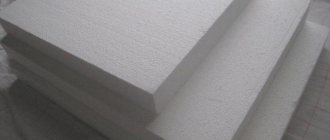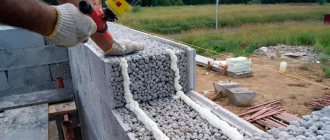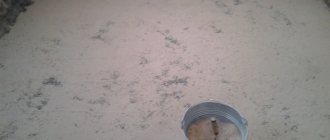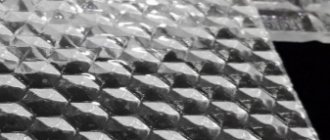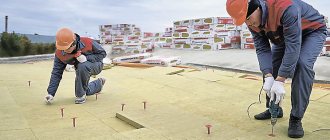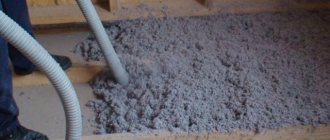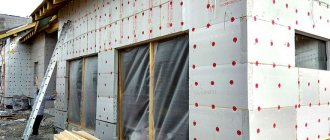Selecting the type of insulation depending on the characteristics of the structure
Also, buildings made of expanded clay concrete are often insulated in a similar way, but instead of brick, other facing materials are used. An example is metal siding. Polystyrene foam often acts as insulation.
Another possible situation is that a house made of expanded clay concrete is already finished with brick, but without a layer of insulation. In this case, you can treat the structure with polyurethane foam.

Insulation of a house made of expanded clay blocks from the outside and inside
Is it necessary to insulate a house made of expanded clay blocks?
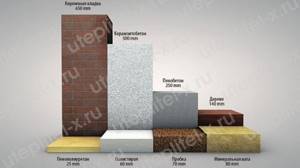
Comparison of insulation materials by thermal conductivity
How to insulate a house made of expanded clay concrete blocks
Insulation of a house made of expanded clay block mineral wool

How to insulate a house made of expanded clay concrete blocks from the outside
Insulation of a house made of expanded clay block with polystyrene foam
Insulation of a house made of expanded clay block with penoplex

How to insulate a house made of expanded clay concrete blocks with foam plastic
Do-it-yourself insulation of a house made of expanded clay blocks
How to insulate a house made of expanded clay blocks from the outside
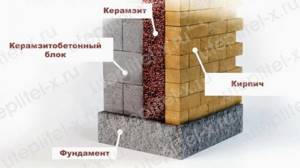
Insulation of a house made of expanded clay blocks from the outside
How to insulate a house made of expanded clay concrete blocks from the inside
An online dew point calculator will help you calculate the thickness of thermal insulation and see where condensation occurs.
Insulation methods
It’s good if the owner thought about thermal insulation of the home at the design stage. This expands the choice of insulation and methods of its application.
There are three possible approaches to thermal insulation of buildings:
- Insulation of masonry. In this case, the heat insulator is laid between the load-bearing and facade (finishing) walls.
- Installing a layer of thermal insulation on the internal surfaces of walls during finishing or major renovation of premises.
- External installation of insulation on a wall made of expanded clay concrete blocks.
Insulation of the walls of an expanded clay concrete house
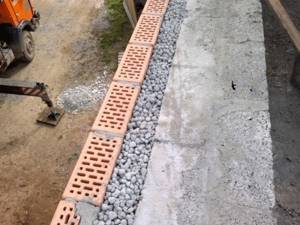
How important is insulation?
How is insulation carried out?
Possible situations
It is easy to insulate a house from the outside using expanded clay concrete if you know the two main options for laying an expanded clay concrete block. It is important to study each one to choose the best one for your home.
There is no external façade cladding
This means that there is nothing except two rows of expanded clay concrete blocks. There are no external façade materials at all. In such a situation, when cladding a building with brick, it is possible to place insulation between the cladding and expanded clay concrete.
Kawabanga! Construction of a house made of sawdust concrete
Facade with facing bricks
With such insulation, the expanded clay concrete house is protected from moisture, rodents, and mold. The only disadvantage of this procedure is the price. In addition, specialists are needed to lay down this material, which also entails additional costs.
How to insulate?
You can insulate a house made of expanded clay concrete using various materials, the most effective and affordable:
Insulating the house from the inside
Experts say insulating your home from the inside is not a prudent decision. Condensation may occur on the walls due to a shift in the dew point; in addition, the walls freeze.
Cement plaster is ideal for expanded clay concrete, as they have a similar composition. This plaster adheres well to the wall and seals all existing cracks.
What materials to use
You can insulate a wall made of expanded clay concrete blocks using various materials:
- Mineral and basalt wool. This is one of the most popular insulation materials. Its advantages: non-flammability, low thermal conductivity, environmental safety and affordable price. The disadvantage of mineral wool is that it requires additional waterproofing, since it easily absorbs moisture and can become unusable over time. Produced in the form of slabs and rolls. The higher the density of the material, the higher the cost.
- Styrofoam. With the help of this lightweight, inexpensive and easy-to-use insulation, you can carry out the work quite quickly, and do it yourself. The disadvantages of such a solution include the instability of the material to moisture and pests, and a fire hazard. Available in slab form.
- Glass wool. Withstands temperature changes, does not become damp and is cheaper than mineral wool. However, when working with the material, you must strictly observe safety precautions - the smallest fibers of glass wool can damage the respiratory tract and skin.

- Penoplex. It has characteristics similar to polystyrene foam, but is more expensive and practically does not allow air to pass through. Resistant to rodents and high humidity. It is produced in the form of plates with locks, thanks to which the process of installing insulation is simplified as much as possible.
Advice! When answering the question of how to insulate an expanded clay block from the outside, experienced builders recommend mineral or basalt wool.
Materials for insulating a house made of expanded clay blocks
There are many insulation materials on the construction market that have different characteristics. But not all of them are suitable for insulating expanded clay. They can all be divided into two large groups:
- Organic type, made from natural materials.
- Inorganic type, made from artificial raw materials.
For insulation inside, it is recommended to use organic insulation materials, as they will not affect health. Synthetic ones will also work on the outside. What is the best way to insulate houses?
Mineral wool
A classic among heat insulators. This is an environmentally friendly product, as it is made from rocks: basalt, glass, slag. The creation process creates fibers with a lot of air between them. Available in the form of hard mats or soft rolls.
Advantages of mineral wool:
The downside is that the material is afraid of moisture and does not dry well. When wet, it loses its characteristics. And the cost is higher compared to other materials.
Styrofoam
Folk insulation. It is valued for its low cost along with excellent characteristics. Sold as rigid slabs. It is obtained by foaming plastic masses. There is air in the cells. Advantages:
- The thermal conductivity coefficient is even lower than that of mineral wool.
- Absorbs sound and makes the room quiet.
- It is light in weight and will not load walls made of expanded clay concrete blocks.
- Affordable price.
- Not afraid of temperature fluctuations.
- Not afraid of moisture. When wet it will not lose its characteristics.
But the heat insulator is not without its disadvantages. They are:
Foam insulation is in demand, since with proper protection it will last a long time, and the cost of the material is low.
Expanded clay

The disadvantages are hygroscopicity, good compaction is required, and labor costs. A high-quality insulation layer that will fully perform its functions is 50 cm.
Polyurethane foam
The material has disadvantages:
Penoplex
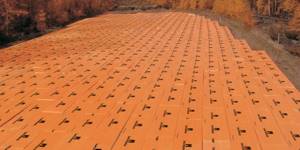
- Not afraid of moisture.
- Low thermal conductivity, good sound insulation, light weight.
- Good compressive and flexural strength.
- Operational period 50 years or more.
- Doesn't rot.
- Easy to install and process.
- High price;
- When exposed to UV rays, it begins to deteriorate;
- Rodents and insects spoil the insulation;
- It burns and releases toxic substances.
Insulation options
It is recommended to lay the layers of the wall cake in the desired sequence. The higher the vapor permeability of the material, the closer it should be to the room.
Mineral wool
The main advantages of this material are environmental friendliness and fire safety. However, when using stone wool, a vapor barrier layer is required.
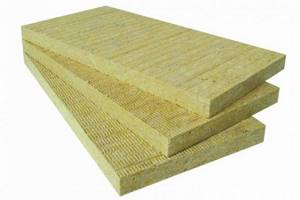
Mineral wool is environmentally friendly.
Foam plastic
When insulating a facade with this material, you need to remember that the slabs require protection from mechanical stress with plaster or siding. Polystyrene foam is characterized by low cost and ease of installation. The plates are fixed to the surface with glue and dowel nails.
Penoplex
Extruded polystyrene foam is a durable and dense insulation material that is insensitive to high humidity. It is well suited for installation on the lower parts of the facade. Expanded polystyrene is recommended to be used only for external thermal insulation: when heated, it releases toxic substances - styrene.
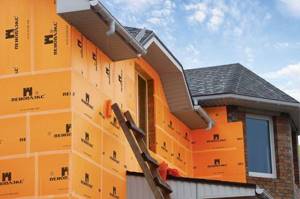
Penoplex is a durable and dense insulation material.
Polyurethane foam
The material is plastic filled with air bubbles. It comes in spray foam or slab form. Polyurethane foam adheres well to any surface, but it emits harmful substances when heated and is sensitive to ultraviolet rays. Before installation, you need to carefully prepare the walls.
Expanded clay
The insulation consists of porous granules made from baked clay. Bulk material is used for thermal insulation of roofs and floors. The walls are insulated only using well technology. In this case, at the construction stage, cavities are created into which granules are poured.
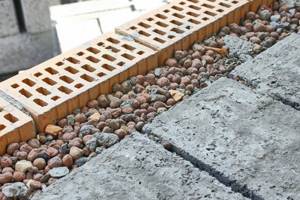
Expanded clay is a porous granule.
Insulation of walls made of expanded clay concrete blocks
Why is it worth insulating?
It is worth remembering that insulating walls made of expanded clay concrete blocks will not only help maintain more comfortable conditions in the house, but will also extend its service life, as it protects against condensation in the walls.
What materials should be used for insulation?
Before carrying out work on wall insulation, it is necessary to plaster the surface on both sides. This also helps keep the house warm. Insulation of expanded clay concrete buildings occurs using the following materials:
Many professional builders recommend mineral wool. But penoplex is being used more and more often. This is due to the ease of fixing it on the walls and the absence of the need to create waterproofing.
How to insulate a house with mineral wool
All work on insulating a house made of expanded clay concrete thermal comfort blocks occurs as follows:
Which method of external thermal insulation to choose?
When creating houses from expanded clay concrete, insulation is carried out in three ways:
- in-wall insulation;
- ventilated facade;
- thermal insulation using the “wet” method.
Kawabanga! House with monolithic walls made of large-porous expanded clay concrete
To understand which of the presented methods is more preferable, it is worth considering the features of each of them.
A ventilated facade is a method in which a frame is constructed, covered with facing material. In this case, the created structure carries an additional load on the wall. Due to the increased weight of the structure, using this method is not recommended.
Wet insulation has the following advantages:
It is worth noting that partitions in a house made of expanded clay concrete blocks are not insulated.
Selecting the type of insulation depending on the characteristics of the structure
Also, buildings made of expanded clay concrete are often insulated in a similar way, but instead of brick, other facing materials are used. An example is metal siding. Polystyrene foam often acts as insulation.
Another possible situation is that a house made of expanded clay concrete is already finished with brick, but without a layer of insulation. In this case, you can treat the structure with polyurethane foam.
Insulation of the building
The question often arises: is it necessary to insulate a building made of expanded clay block? Due to its porous structure, the product has relatively low frost resistance. Therefore, houses made from such blocks require additional thermal insulation.
- In addition, in addition to creating a comfortable microclimate in the house, insulation creates additional protection from the influence of the external environment, which significantly increases the durability of the building.
- In this article we will look at how to properly insulate a building from the outside.
- For insulation, you can also use three types of thermal insulation: mineral wool, polystyrene foam and extruded polystyrene foam (penoplex).
- Experts do not recommend using the last two materials based on the following considerations. Polystyrene foam has poor vapor permeability. Vapors penetrating through the surface turn into condensate and have a destructive effect. In addition, it is susceptible to rodents.
- Penoplex, due to its density, does not allow the structure to breathe and is quite expensive, but does not require additional waterproofing.
- Mineral wool (both rolls and mats) is the best option for insulation. It has numerous advantages: it is non-flammable, does not rot, is characterized by good sound and heat insulation, and does not suffer from rodents.
It is more correct to insulate a building from the outside, since in this case the dew point will be on the surface of the building and its service life will increase.
GOST 52953-2008 divides mineral wool into three types:
- Slag.
- Glass wool.
- Stone (basalt).
Characteristics of mineral wool:
| Name | Slag | Glass wool | Basalt |
| Thermal conductivity, W (m2*K) | 0,46-0,48 | 0,039-0,047 | 0,035-0,041 |
| Operating temperature, ᵒС | -60…+250 | -60…+450 | -180…+700 |
| Hygroscopicity, | High | Low | Absent |
| Heat capacity, J/kg*K | 1000 | 1050 | 1050 |
| Moisture absorption,% by weight in 24 hours | <1.9 | <1.5 | <0.095 |
| Fiber structure | Brittle, prickly | Brittle, prickly | Smooth, not scratchy |
To insulate a building, experts most often recommend using stone wool. However, only the owner of the building can decide how to insulate the house outside, focusing on his taste preferences and financial capabilities.
Types of insulation
External thermal insulation with this material can be done in two ways:
- Installation of a “wet” facade.
- Installation of a ventilated facade.
Both methods combine thermal insulation and finishing work. Brief step-by-step instructions: how to insulate a house made of expanded clay block from the outside:
The principle of a wet facade, stages of work
It is recommended to use mineral wool slabs PPZh 160-PPZh200 as insulation:
- Install scaffolding. Treat the surface. Clean the surface with sandpaper and remove dust. Apply a layer of primer to ensure adhesion to the insulation.
- Apply glue diluted according to the instructions to the heat-insulating product and to the wall surface.
- It is recommended to start installing thermal insulation from the bottom and fasten it in a circle. Attach the next row of insulation in a checkerboard pattern.
- A day later, after the glue has dried, additionally fix the wool with dowels (dowel anchors with plastic cores are usually used to fix the insulation).
- Carry out reinforcement by gluing fiberglass mesh. It must be mounted vertically. Apply glue and press the mesh into it. Heavy systems are reinforced with galvanized wire mesh.
- Apply another layer of glue and wait until it dries. Perform priming. After this, plaster the surface. To increase the insulating properties, plaster with the addition of perlite or foam glass is used.
- The last stage is painting.
How the wet facade works is clearly visible in the photo:
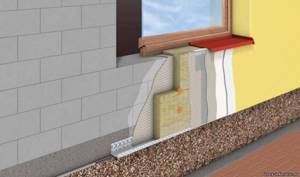
Installation of a wet facade
This method is the most economical and does not lead to a significant increase in load.
Foam insulation
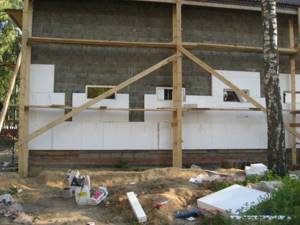
Use only special glue.
Instead of mineral wool, a material such as polystyrene foam can be used as insulation for the walls of a house made of expanded clay concrete blocks. This option is less environmentally friendly, but it is quite inexpensive.
Insulation of walls in a house made of expanded clay blocks is carried out using the following technology:
Insulation of block walls with materials such as polystyrene foam and mineral wool is one of the most common. These materials are lightweight, easy to install, inexpensive, and perform excellent functions in insulating the walls of the house.
Thus, there is nothing complicated in this process. If you approach the matter thoroughly, with all diligence and care, there is no doubt that the result will be excellent.
What are expanded clay concrete blocks according to GOST
Expanded clay concrete is classified as lightweight concrete. A porous material, expanded clay, is used as a filler. These are round granules made of baked clay. The composition of expanded clay concrete is cement, sand, expanded clay and water. When preparing the mixture, more water is poured than in ordinary heavy concrete, since expanded clay is hygroscopic and absorbs liquid. When producing blocks, the finished mixture is poured into molds, left until initial hardening, after which they are removed from the mold. In principle, the blocks are ready, but they cannot be used until they reach their design strength.
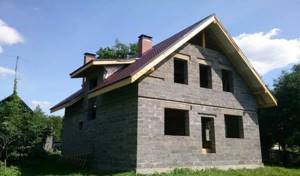
A house made of expanded clay concrete blocks can be built quickly
There are two technologies for bringing products to normal strength at the factory - in an autoclave and by vibration pressing. In the first case, the blocks are sent to an autoclave, where the material is treated with steam under pressure. This makes expanded clay concrete blocks more durable. The second method is vibration with simultaneous pressure. When vibrating, all voids disappear, the solution becomes more homogeneous and fluid, enveloping each of the expanded clay granules. The result is high strength indicators.
In artisanal production, the blocks are simply left to “ripen.” In theory, it takes at least 28 days until the concrete gains strength. But they can sell it earlier so as not to take up space. Nobody guarantees durability.
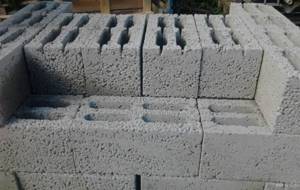
Round granules of expanded clay can be seen on the surface of the block. Depending on the brand, they can be of different sizes, in larger or smaller quantities
The fact is that for cement to gain normal strength, it is necessary to create a certain heat and humidity regime. In this regard, expanded clay concrete is more capricious than ordinary concrete. Due to the high absorption capacity of expanded clay, it can take up too much water. And the liquid will not be enough for the concrete stone to gain strength and not just dry out. Therefore, it is advisable to water the finished blocks and cover them with film at least for several days after production. They cannot be kept in the sun and the temperature should not be lower than +20°C. Otherwise, expanded clay blocks will never gain the required strength and will crumble even under light loads and impacts.
When it comes to price, factory units are more expensive. But still. If you are building a house, and not a utility block or barn, you should not save money and buy “garage”-made blocks. Quality is a big question here.
Foam insulation

Use only special glue.
Instead of mineral wool, a material such as polystyrene foam can be used as insulation for the walls of a house made of expanded clay concrete blocks. This option is less environmentally friendly, but it is quite inexpensive.
Insulation of walls in a house made of expanded clay blocks is carried out using the following technology:
Insulation of block walls with materials such as polystyrene foam and mineral wool is one of the most common. These materials are lightweight, easy to install, inexpensive, and perform excellent functions in insulating the walls of the house.
Thus, there is nothing complicated in this process. If you approach the matter thoroughly, with all diligence and care, there is no doubt that the result will be excellent.
Work procedure for insulation
To insulate expanded clay concrete walls yourself, you should strictly adhere to the work technology. The process consists of several stages: preparing the surface, preparing the solution, applying an adhesive composition to the slabs, installing insulation, creating a vapor barrier layer, reinforcement, cladding.
Materials and tools
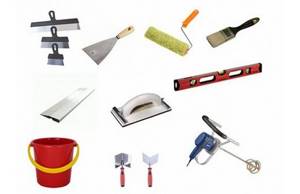
To work you will need:
- insulation;
- fiberglass facade mesh;
- primer;
- adhesive composition for insulation;
- putty;
- drill with a nozzle for mixing the solution;
- containers for preparing glue and putty;
- cuvette and brush for applying primer;
- construction level;
- spatulas - narrow, wide, serrated;
- umbrella-shaped dowels;
- construction knife;
- polyurethane foam;
- roulette;
- vapor barrier material (membrane);
- construction tape.
Depending on which cladding method is chosen, other materials will also be needed: brick, siding or facade plaster.
Preparation

The surface is cleaned of debris, dust and dirt. Apply a layer of primer, wait until it dries, and proceed to applying plaster. The wall is primed again to ensure high-quality adhesion of the insulation to the surface.
The next stage in the process of insulating walls made of expanded clay blocks is preparing the solution. Today, a large number of adhesive compositions are produced, and when choosing, you should pay attention to ensure that it is suitable for the selected insulation. The solution is prepared following the instructions on the package.
Application of composition and installation of slabs
The glue must be applied using a notched trowel, spreading it over the entire surface of the wall in a thin layer. There should be no empty areas. After this, the composition is applied to the slab itself - around the perimeter and in the center.
Installation starts from the bottom of the wall and proceeds sequentially along the perimeter of the building. With this method, all the slabs in the first row will have time to be firmly fixed, and the load from those installed above will not move them. The evenness of the position of each slab is checked using a building level. The second and subsequent rows are performed with a shift of half the length of the slab. To do this, cut the slab in half using a construction knife.
If in some places the sheets do not fit tightly together, the space is filled with polyurethane foam.
Additional fixation and installation of vapor barrier
After the adhesive solution has hardened (about a day later), the insulation is additionally secured to the expanded clay concrete using dowels. They are driven in around the perimeter of the slabs and in the center.
When using mineral or basalt wool, a vapor barrier layer is required to protect the material from getting wet. For this purpose, special membrane films are used, which also protect from wind. The film is secured by placing the strips vertically. In this case, each subsequent strip must overlap the previous one by at least 10 cm. The joints are glued with construction tape.
Reinforcement

Proceed to the installation of the reinforcing mesh. It is mounted vertically. Using a tape measure, measure the height of the wall and cut off a piece of mesh of the required length. Apply plaster to the insulation area and press the mesh into it. This must be done quickly, before the plaster hardens. In order to level the surface of the plaster while pressing the mesh, it is recommended to use a façade spatula for the work.
Finishing
After insulation of expanded clay concrete walls, cladding can be done using brickwork, installing siding or using plaster.
Plaster the wall after the layer of composition on which the reinforcing mesh is fixed has completely dried. After this, the surface is primed again, wait until the wall dries, then begin applying the starting and finishing compositions. The final stage is painting the facade.
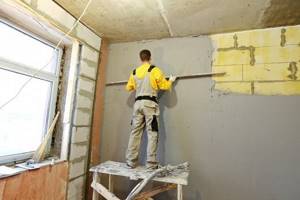
The second possible option is installing siding. In this case, reinforcing mesh is not required; the cladding is installed directly on the slabs. Since the “wet” method does not require the installation of sheathing, installation of siding will require the installation of anchors on which the slats will be attached.
Why is brick cladding less popular than the “wet” method? It requires creating a foundation and waterproofing it. This entails additional financial and time costs.
It is necessary to insulate the walls of a building built from expanded clay concrete blocks - this not only reduces heat loss, but also extends the life of the house. The cost of the materials that will be required is affordable, and the work itself is quite feasible to carry out on your own.
How and how to insulate a house made of expanded clay concrete blocks from the outside
Modern building material in the form of expanded clay concrete blocks is reliable and durable.
Additional advantages include frost resistance and water resistance. It is due to these characteristics that it is in great demand among developers.
Let's consider several options for wall insulation.
Characteristics of expanded clay concrete block
1. house walls 40 centimeters without external brickwork
External insulation of expanded clay block house
2. house walls 40 centimeters thick with facing masonry
Insulation of a house with facing masonry
How to insulate?
You can insulate a house made of expanded clay concrete using various materials, the most effective and affordable:
- Mineral wool. It has high thermal insulation characteristics and is a budget material. Provides protection for expanded clay blocks from moisture, dampness, and temperature changes. They are laid in two layers, between which a waterproofing and windproof layer is placed. Aluminum foil provides a vapor barrier.
- Glass wool. Provides good thermal insulation in the house. This is an environmentally friendly material that is used to insulate both the outside and inside of the house. In the first situation, the insulation is placed between foam plastic and expanded clay concrete, and in the second - between the wall and the gypsum structure. Plastering over insulating materials will enhance their properties.
- Styrofoam. A budget option, but it is flammable and can be damaged by rodents. It is advisable to place a reinforced mesh on top of the foam so that birds and small rodents do not have access to it.
- Penoplex. This material is similar to polystyrene foam, but it is not interesting to rodents, is more durable and repels water well. It is believed that penoplex is the best material for insulating houses.
Return to contents
How to insulate a house made of expanded clay concrete blocks - Proraboff.rf
Why thermally insulate a house made of expanded clay concrete?
How to insulate a house made of expanded clay concrete
What situations are possible
There are two options for constructing expanded clay concrete masonry, which seriously affect thermal insulation measures. It is worth considering them so that you can choose the most successful method of insulating a house made of expanded clay concrete blocks.
1. There is no external cladding of the facade
2. The facade is additionally lined with facing bricks
How to insulate a house made of expanded clay concrete
If the owner has chosen a method of performing thermal insulation, he will need to select a suitable insulation. An expanded clay concrete house can be protected from the cold by a variety of thermal insulation materials. These are considered the most successful.
1. Mineral wool
2. Polystyrene foam when insulating the facade
3. Penoplex as a material for insulation
Internal insulation of a building made of expanded clay blocks
1. Gypsum plaster. Its weight is less, and its thermal insulation capabilities are higher. But an obvious disadvantage should be considered the low adhesion of gypsum plaster and expanded clay concrete. Therefore, the owner will first have to carefully prepare the surface.
Choosing insulation for expanded clay block video
Expanded clay concrete blocks and their purpose
The material is made from cement, water, sand and expanded clay, which plays the role of filler. Less commonly, other components are included in the composition, such as gravel and shungizite. When mixing ingredients, precise proportions are not observed; only the recommended ratios are taken into account.
Changing them affects the properties of blocks in different ways. Depending on the performance characteristics (strength, thermal conductivity), the products are used for the construction of load-bearing structures or partitions, and insulation of finished walls.
Features of insulating walls made of expanded clay concrete
Characteristics of the material from the point of view of thermal engineering
The thermal conductivity of a material strongly depends on its density. Among expanded clay balls the following classification can be given:
Comparative characteristics of the thermal insulation properties of various materials
- construction materials - density 1200 - 1800 kg/m3;
- structural and thermal insulation - density 500-1000 kg/m3.
Materials for thermal insulation
Manufacturers now offer a fairly large range of thermal insulators. To protect walls you can use:
- mineral wool (slabs and mats);
- Styrofoam;
- extruded polystyrene foam (penoplex);
- polyurethane foam;
- ecowool;
- “warm” plaster.
The most common of these methods are mineral wool and expanded polystyrene (foam plastic and penoplex). Their thermal insulation characteristics are approximately equal.
Thermal calculation
When purchasing blocks, the manufacturer must always indicate their properties. The calculation determines the thickness; to perform it, a characteristic such as thermal conductivity will be required. There are two ways to perform this calculation:
- "manually";
- using special programs.
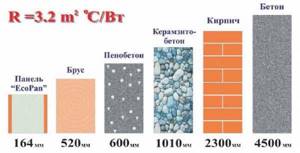
Reduced heat transfer resistance of a wall made of expanded clay concrete compared to other materials
It is not difficult to perform an independent calculation, but for a person who does not have a construction education, it can cause difficulties. It is best to use the simple Teremok program, which works in two modes:
- calculating the thickness of one of the layers of the wall structure;
- checking the heat transfer resistance if the thickness has already been selected.
To work with the software, you will need the following initial data:
- thermal conductivity of expanded clay concrete blocks;
- block width;
- thermal conductivity of insulation;
- insulation thickness (not needed if working with the program in the first mode).
Having selected the values, you can begin insulating the walls of the house.
Work production technology
The process of protecting walls with insulation depends on its type. For different materials, the technology has slight differences, so it is worth considering each of them separately.
Mineral wool
Mineral wool is attached to a pre-installed frame. The work should be done in the following order:
- cleaning the wall surface;
- fastening vapor barrier;
- frame installation;
- installation of insulation;
- waterproofing;
- finishing of the facade with provision of an air-ventilated layer, at least 5 cm thick.
The layer is needed to remove condensation from the insulation, which loses its properties when wet.
External insulation
Insulating the facades of houses is the best of the proposed options:
- After finishing, the building takes on a well-groomed appearance;
- The dew point moves closer to the outside of the block;
- It is possible to use any type of insulation without the risk of harming the health of residents;
- Interior spaces do not lose usable space;
The disadvantages include:
- Additional costs for steam and waterproofing;
- Impossibility of work in the cold season.
Materials for insulating external walls
The qualities and characteristics of different types of polystyrene, basalt wool and polyurethane are described above. Often, mineral or glass wool, formed into separate sheets or packaged in rolls, is used for insulation.
The main advantage of these materials is their affordable price. However, it's not worth saving. Mineral wool has a high moisture absorption rate, cakes and thins with poor waterproofing, losing some of its thermal insulation properties.
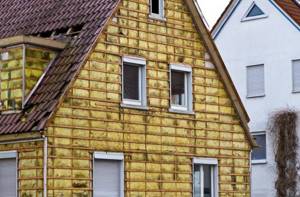
Mineral wool as insulation for facades
The disadvantage of glass wool is that it is difficult to install - it is necessary to use skin and breathing protection due to the small volatile fraction, which scatters even when touching the mat.
In terms of thermal conductivity, the materials are inferior to stone wool, and they also lose some of their properties over time.
Types of external thermal insulation
There are two fundamentally different ways of carrying out external thermal insulation of walls:
- Wet. Sheets of insulation are glued to the walls and plastered. During operation, thermal insulation is influenced by external weather conditions.
- The dry method, or ventilated facade, involves waterproofing insulation and finishing with panel materials.
Wet method
This type of insulation involves the use of polystyrene foam, penoplex, and stone wool.
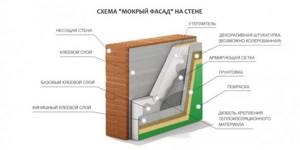
Structural composition of the “wet” facade
Algorithm of actions:
- Level the walls, sealing the recesses, seams between the blocks, removing the build-up of masonry mixture.
- If the masonry is of poor quality, level the walls with plaster and treat the surface with a deep penetration primer for exterior work.
- Glue is applied to the surface of the thermal insulation sheets, choosing its type based on the manufacturer’s recommendations.
Important! Polystyrene foam with a density of 15 kg/m3 is not suitable for wet thermal insulation - it is not intended for load. They use material marked PSB-S-25, which requires plastering.
- Glue the sheets to the wall surface. After the solution has dried, the insulation is additionally strengthened with dowels with wide heads.
- The adhesive plaster is applied in a thin layer to the insulation.
- A plaster mesh for external use is placed on the surface of the sheets and embedded in the initial layer of glue.
- Finish plastering is carried out, choosing mixtures for external use or, for example, a “bark beetle” mixture.
- After drying, paint the surface with facade paints.


